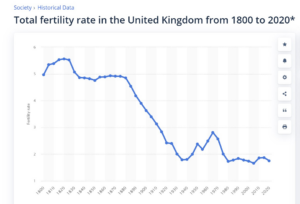
This post needs reading in conjunction with Has Healthcare Gone Mad and A Medical Triumph.
This image of declining British fertility from 1880 was repeated across the Western world and more recently the whole world. The usual explanations are in terms of social and economic factors and are typically seen as a good thing. Progressives see women getting more control over the reproductive process, through the availability of contraception, more rights and openings for personal development. Education is cited as playing a part.
Things get a little trickier around 1980 when fertility rates drop below 2.1 and the native population is no longer replacing itself. Will we have to turn to and tax immigrant workers to support an ageing population? More generous maternity and child support arrangements and job guarantees have been put in place in France and elsewhere to staunch the hemorrhage. Without much success.
A less commonly heard viewpoint is that the fall in fertility coincides with physical factors like a rise in pollution and more recently endocrine disrupting chemicals. Falling male sperm counts are pointed to as the canary in the coalmine for folk taking this point of view – social and economic factors seem less likely to cause this.
The important point to note from here is no-one knows what is causing the fertility changes since 1980.
The Has HealthCare Gone Mad post makes the point that up to 1 in 6 of British people are taking antidepressants, mostly serotonin reuptake inhibitors and these cause sexual dysfunction, loss of libido, lowered sperm counts, failed implantation, increased miscarriages, and voluntary terminations. It is at least plausible that these are contributing to the problem.
Britain’s fertility rate has dropped to 1.56 and might be a lot lower in the native population as immigrant and non-Judaeo-Christian faith communities are slower to turn to medicines than the natives. Within the UK the place with the lowest fertility rate is Scotland – with figures of 1.31 in 2020 and 1.29 in 2019.
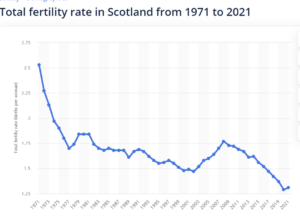
Scotland is also the nation with the highest consumption of antidepressants in the UK – one in four of the population are taking them. Again consumption of antidepressants is more likely in the native population rather than newly arrived groups or among non-Western faith communities.
The UK, along with Portugal, Spain and Sweden rank among the highest consumers of SSRIs. The Portuguese fertility rate currently stands at 1.40. Sweden is better at 1.66. Spain is the most striking.
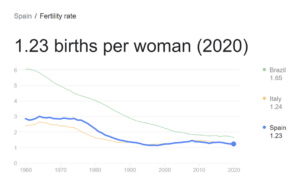
Both Spanish and Italian fertility rates are causing concern. Estimates are that by 2050, both countries will have only three-quarters of the population they now have. It looks like the only way to keep the social structure in place is to allow millions (literally millions) of immigrants in but as things stand now both countries are concerned about the effect even current levels of immigration are having on their identity – culture etc. Accepting immigration on a much greater scale seems unimaginable.
At present, these questions are primarily Western European ones – Eastern fertility rates are better. Among Western countries, France has done better than others in holding fertility rates stable. Interestingly, following concerns about SSRIs given to French teenagers, a recent set of reports looked at possible impacts of SSRI antidepressants on sperm counts in rats. This research going back two decades shows dramatic declines in sperm counts.
There is official huffery and puffery about sperm counts returning to normal but this looks like returns to normal once the rats stop the drugs whereas many humans can’t stop. We also don’t know if the rat data means a return to normal after stopping several (rat) weeks after starting compared with several (rat) years after starting. Nor do we know if boys going through puberty on these drugs return to normal. Nor have the French authorities (HAS and ANSM) addressed the research indicating that rats on SSRIs while pregnant have asexual offspring.
The Spanish and Italian fertility figures are lower even than the 1.34 Japanese rate which is leading to much angst in Japan with projections that by 2040 over one third of the country will be over 80 years old and by mid-century it may have lost a third of its current population.
In January this year, the Prime Minister, Fumio Kishida, warned Japan is on the brink of not being able to function as a society because of its declining birth rate – but immigration is not acceptable nor even migrant workers. However bad a horror, or at least nervousness, about mass immigration might seem, a turn to mass migrant workers almost feels like a return to slavery. There is no chance of them becoming one of us, although down through human history people haven’t kept strictly to the sexual rules.
SSRIs came later to Japan – only taking off around 2000 after which their use has increased hugely. But Japan had and still has an even heavier benzodiazepine consumption than the West and benzodiazepines can also impact fertility, by interfering with embryo implantation, by leading to low birth weight, pre-term births and possibly neonatal deaths. The profile of benzodiazepine effects is very SSRI like, especially with the later more potent benzos which have a profile that points to peripheral neuropathy effects consistent with SSRIs and thalidomide.
Throw in mood stabilizing anticonvulsants like gabapentinoids and valproate/Depakote and the idea these drugs are not contributing to fertility and related problems at least to some extent becomes ‘inconceivable’.
Pharmageddon
Over the Halloween weekend this year, staff in Walgreens and CVS pharmacies went on strike over conditions. Staff numbers have not expanded in line with a growing workload and pharmacists are concerned that the situation is becoming increasingly dangerous.
There are huge dangers in people being on the ten or more drugs many are now on, if they are prescribed correctly, but even more dangers if owing to the pressure of a workload, the pharmacist gets some of those medicines wrong. Between cramped conditions, poor pay, having to give vaccines in addition to dispense a tsunami of prescriptions, pharmacists figure they, and we, are facing Pharmageddon. Pharmageddon became the brand name for their actions – with US friends drawing it to my attention.
In most recent lectures, I have mentioned our growing polypharmacy and attributed a stalling and now falling life expectancy in part to this. As with many of these things the US leads the way and the outcome is striking.
A recent paper by Jacob Bor and colleagues features this graph, showing US Mortality Rates (the red line) were better than the Western average (the broken black line) through to the mid-1980s. The graph from 1930 to 1980 is even more striking – no one in their right mind would have wanted to live anywhere but in the US. After the mid-1980s US figures began worsening slowly – like the sand initially seeming to flow slowly through an hourglass – but they are now dramatically worse than the average of other developed countries.
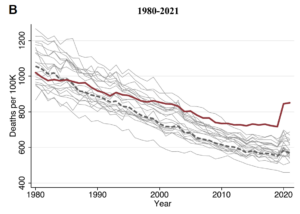
The mid-1980s coincided with a turn to treating risk factors, rather than just diseases, a turn to giving us problems that suited companies, rather than the traditional medical use of company products to help us live the lives we wanted to life. A shift to treating us for multiple risk factors inevitably leads to polypharmacy, a word that appeared on our radars around 2000. It was billed as a problem for older adults, not something the rest of us had to worry about. But polypharmacy has now reached down into the teenage years and is even happening in utero – with women taking an increasing number of medicines in pregnancy and up to 7 vaccines while pregnant.
All sorts of social and economic factors are thrown into the mix to explain these data, from poverty to Covid (Covid is also a favorite explanation as to why women have been less likely to get pregnant), and these may play a part but it seems unbelievably unlikely that polypharmacy is not also playing a significant part.
It’s white, university educated, liberal-leaning, white women, some of them bioethicists, who are leading the way in consuming drugs during pregnancy and their life expectancies are falling also.
We have no problem in figuring that drugs like alcohol and nicotine and street drugs might be killing us. We think its obvious that if you are taking several of them you are more likely to die early than if you are just on one of them But we are pretty resistant to the idea that our on-prescription sacraments could be having similar effects, and that taking ten or more of them might similarly lead to a premature death. We cannot conceive of the fact that nicotine for instance is likely to be at least as effective as many SSRIs for the conditions SSRIs are given for – and provided it is not smoked it looks like it may also be safer for many, perhaps even most, people.
Its worth making a point here. Street drugs and prescription drugs are chemicals. What makes one of these chemicals into a medicine is the information that comes with them. The information that comes with prescription drugs is effectively fraudulent. Lots of folk on the street, testing these things for themselves likely keep each other nearly as safe as our doctors are capable of keeping us.
Substance Abuse
It is a sign of a sophisticated mind, F Scott Fitzgerald said, to be able to hold two contradictory things in mind at the same time and still function.
There is a comfort and simplicity to viewing things in terms of Black and White. Nowhere is this more obvious than when it comes to drugs – street and even dinner table drugs bad, prescriptions drugs good even sacramental – this means they can only benefit and cannot harm. We like to view our problems in terms of social and economic factors, but at the same are much more likely to turn to biological interventions like vaccines or drugs to solve them rather than embrace political or social action.
On October 16, the Canadian Medical Association Journal published a Guideline for the Clinical Management of High Risk Drinking and Alcohol Use Disorder.
On October 16, the British NHS published a Draft Guideline for Alcohol Treatment.
These documents come from different planets. The Canadians introduce the idea that SSRIs can cause alcohol use disorder and clinicians should be alert to the possibility that this might be happening in the person in front of them, and clinicians should also not use SSRIs to treat alcohol use disorder. This very simple move, based on the latest evidence, stands a chance of eliminating a number of problem alcohol cases, in particular perhaps among the Desperate Housewife class.
In a vastly longer draft document, the Brits don’t mention SSRIs. They figure one of the important reasons that we have alcohol problems is that its use is stigmatized making it difficult to seek treatment. Muslims stigmatise its use and have very low rates of alcoholism.
People with alcohol problems can feel shame but not an extraordinary amount. In AA meetings folk are quick to berate anyone who says (correctly) they think their problem is linked to the SSRI they are on. Someone like this, bewildered at an abrupt onset of alcohol use, who has crashed a car and maybe killed someone is much more likely to feel shame and stigma than a lifestyle alcohol use problem. The draft has not a mention of the need to avoid stigmatising the person for getting it right. The promoted option is a course of CBT, that will likely uncover the trauma that has led to the recent onset alcohol use – even though CBT should not be uncovering trauma.
The divide between the Canadian and British Guidelines – see Medical Triumph for more details – illustrates something that we need to grapple with in the realm of fertility, sexual function, and life expectancy also. The stakes in terms of fertility and life expectancy could not be higher.
Japan, Finland and Canada
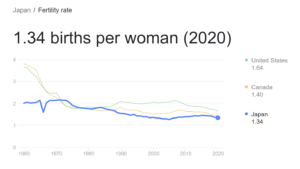
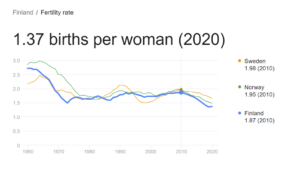


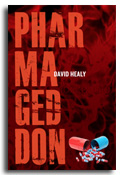
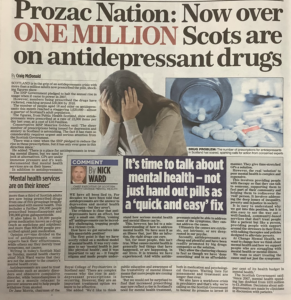


Pharmageddon
The divide between the Canadian and British Guidelines – see Medical Triumph for more details – illustrates something that we need to grapple with in the realm of fertility, sexual function, and life expectancy also. The stakes in terms of fertility and life expectancy could not be higher.
“Go Set a Watchman”
Atticus Finch
Pharmageddon is the Story of a Tragedy
https://davidhealy.org/pharmageddon-is-the-story-of-a-tragedy/
This example of a shepherding of innocents into pharmaceutical killing fields is not an isolated incident. Life expectancy in the US, the country that consumes most of the latest life-saving drugs is falling rapidly compared to the rest of the world. For diseases like schizophrenia, we are now doing 10 times worse in terms of life expectancy than we were 100 years ago.
Not even the FDA has access to the data.
Prescription-only arrangements mean that doctors have to give us diseases if they want to give us pills.
In order to move the product, prescription-only arrangements also mean that doctors have to give us diseases if they want to give us pills and as a result we are all becoming more and more diseased than ever before.
“David Healy is a serious man. As a caring clinician and internationally recognized expert in pharmacology, epidemiology and the history of psychiatry, this Irish professor may be reminiscent of both Sherlock Holmes and Atticus Finch.”
“Finally, if there is only one thought you want remember from this book, it should be this almost prophetic counsel by Philippe Pinel, from two hundred years ago: “It is an art of no little importance to administer (medication) properly, but it is an art of much greater and more difficult acquisition to know when to suspend or altogether to omit them.”
Amen.
Bernadette Grosjean.M.D.
Associate Professor of Psychiatry
David Geffen School of Medicine at UCLA
There have been a number of comments not posted because they strictly speaking have nothing to do with fertility issues.
I desperately need readers to dig up angles on these fertility issues – even angles that say the argument here is wrong.
Better have no comments – which just might alert readers to the silence around these issues, than to have lots of comments off-topic.
David
Hi David, I’m wondering if a contributing factor to decline in birth rates could be an overall increase in socio-economic status of general population, or women being more educated? Just a thought.
Linda
The traditional story is that education played a huge part from 1880 onwards the opportunities for women that opened up. And I’m not arguing with this. The issues are complex.
But is education playing a role in reproductive replacement rates falling dramatically below 2.1? In Spain where they have fallen to 1.2, educated women are slightly above the average. In most of Europe, educated women are the one’s accessing IVF – with rates of birth by IVF now exceeding 5% in an increasing number of countries – this doesn’t suggest educated women are no longer interested to have children. It suggests they can’t or are failing either for reasons in them or perhaps their husbands sperm counts.
It would be great to get data from IVF clinics as the factors they record as leading to infertility and any advice they give couples to what they can do before turning to IVF – although perhaps these clinics have no incentive to map this out.
The data on meds taken during pregnancy, and antidepressants in particular, suggest it is educated women leading the way in consuming more of them and even more bizarrely advocating for the participation of women in RCTs of new drugs and vaccines. There are ways other than RCTs to get the information on safety that is needed – pregnancy registries being one.
The SSRI and alcohol story plays into this. Its educated women, high-fliers, as alcohol institutes call them, who are drinking much more than other women and beginning to outstrip men in their drinking.
Education definitely played an wonderful role in the past. It plays a much more ambiguous role now. I don’t pretend to know what is going on but I do know this is not being talked about and there is a prima facie case for lifting the taboo that seems to prevent us asking questions.
Thanks for raising this point. We need other readers to continue the discussion. We need many more suggestions about where there might be pertinent data that could be thrown into the mix
David
Thank you David. It is very complex, as most things are when looked at deeply.
Last week Patrick Vallance was on a programme hosted by Evan Davis, The Bottom Line, where the subject was Blockbuster Drugs and how they got there. So close, but so far, it was Zantac that was drawn to attention. Evan Davis interviewed Andrew Witty at Chatham House a few years ago and drew attention to the China Bribery Scandal but refrained from addressing Seroxat.
It struck me that Vallance did not, has not yet, addressed Paroxetine and how this programme was so close to almost doing so.
https://www.bbc.co.uk/programmes/m001s5nl
Edward Dowd reposted
Chief Nerd
@TheChiefNerd
“I’ve Never Seen This Before”: Dr. Kimberly Biss Shares Alarming Fertility Data at the ‘Injuries Caused by COVID Vaccines Hearing’ “From what I’ve seen, my average miscarriage rate in 2020, month-to-month, was 4%. That was normal…My miscarriage rate from year to year went up 100%. In 2021, the average miscarriage rate, month-to-month, was 7-8%. We peaked in November of that year for some reason. That’s actually when a non-clinical staff member came up to me and said, ‘Dr. Bis, you realize we’ve had eight miscarriages this month’, which in a practice that delivers 20 to 25 patients, that’s a huge number. In 2022, the average month-to-month rate was 15%. Now, that was up till November. I will tell you in December. I’ve never seen this before. We had 41 newly registered patients. 13 of them lost their babies. So that’s 25% right there.”
@docbiss@RepMTG
https://twitter.com/TheChiefNerd/status/1724175768303866122
Dr Aseem Malhotra
@DrAseemMalhotra
The greatest corporate crime, miscarriage of medical science, damage to population health and attack on democracy we will witness in our lifetime? You REALLY couldn’t make it up.
https://twitter.com/DrAseemMalhotra/status/1724297093257285911
Offers On, Pharmageddon and Fertility…
Flagging Fertility, the cross-over from waning populations to “Paxil as the drug of choice for women” (defects included) …
“She doesn’t recommend switching medications if paroxetine is the only one that works for you.”
Doctor Healy told you that “they altered the prescribing practices in this country,” he recounted. “What they set out to do, they succeeded in doing. They got doctors to prescribe the drug to women.”
Herding Women
July 12, 2012 9 Comments
https://davidhealy.org/herding-women/
Since 2005, Paroxetine, first marketed by GlaxoSmithKline as Seroxat/Paxil, has carried warnings of birth defect risks. These risks led to litigation in the US – but not elsewhere. In the first case that went to court in the US in 2009, the Kilker case, the lawyers for Lyam Kilker argued that, even before Paxil was launched, there was good laboratory evidence that the SSRIs might cause problems, and, that following their initial marketing, further evidence had emerged steadily from 1998 onwards painting a consistent picture that the drugs actually do cause problems in clinical use, and of company efforts to hide this.
Glaxo
Yet since their launch Paxil and other SSRIs have been actively and increasingly promoted to women of child-bearing years. The company most committed to this and most effective at it was Glaxo.
Women of child bearing years in particular who have nervous problems have been encouraged to go to their family doctors where they are all too readily put on an SSRI. These family doctors aren’t aware of the risks of dependence or birth defects, and so don’t warn. The patients become dependent on the SSRI and find it impossible to stop using it when they wish to get pregnant or if they find they are pregnant. In an age where most women will abstain from alcohol, nicotine, tea, coffee, soft cheeses or uncooked meats if they are thinking about becoming pregnant, few of these women would consent to treatment if informed of either the risk of birth defects or the risk of becoming addicted (see We need to talk about doctors).
“GlaxoSmithKline from 2000,” Mangin says, “mounted a multifaceted and targeted national promotional campaign that employed explicit strategies designed to promote sales of Paxil in pregnant women and women of reproductive age.”
An exhibit cited in the report from a “Paxil Tactical Marketing Plan in 2000,” states: “New Paxil data with high media interest, hot flash, postpartum, depression, pregnancy, and lactation will position Paxil as the drug of choice for women.”
Doctor Healy told you that “they altered the prescribing practices in this country,” he recounted. “What they set out to do, they succeeded in doing. They got doctors to prescribe the drug to women.”
https://www.opednews.com/articles/Over-Six-Hundred-and-Count-by-Evelyn-Pringle-100305-479.html
Antidepressants and Pregnancy: Tips from an Expert
https://www.hopkinsmedicine.org/health/wellness-and-prevention/antidepressants-and-pregnancy-tips-from-an-expert
Lauren Osborne, M.D., assistant director of the Johns Hopkins Women’s Mood Disorders Center, talks about why stopping your medication may not be the right approach.
“We can say with strong confidence that antidepressants don’t cause birth defects,” says Osborne. She adds that most studies finding a physical effect on babies from antidepressants taken during pregnancy fail to account for the effects of the mother’s psychiatric illness.
Paroxetine:
Early studies on a small number of patients connected the SSRI paroxetine with cardiac defects in babies. However, these studies didn’t account for smoking, obesity and other risk factors that are more common in women who have depression. Osborne says larger, more recent studies show no such link with cardiac defects. She doesn’t recommend switching medications if paroxetine is the only one that works for you.
If P for Paroxetine was such a marvel for pregnant women, why is P for Populations having a Pregnant Pause?